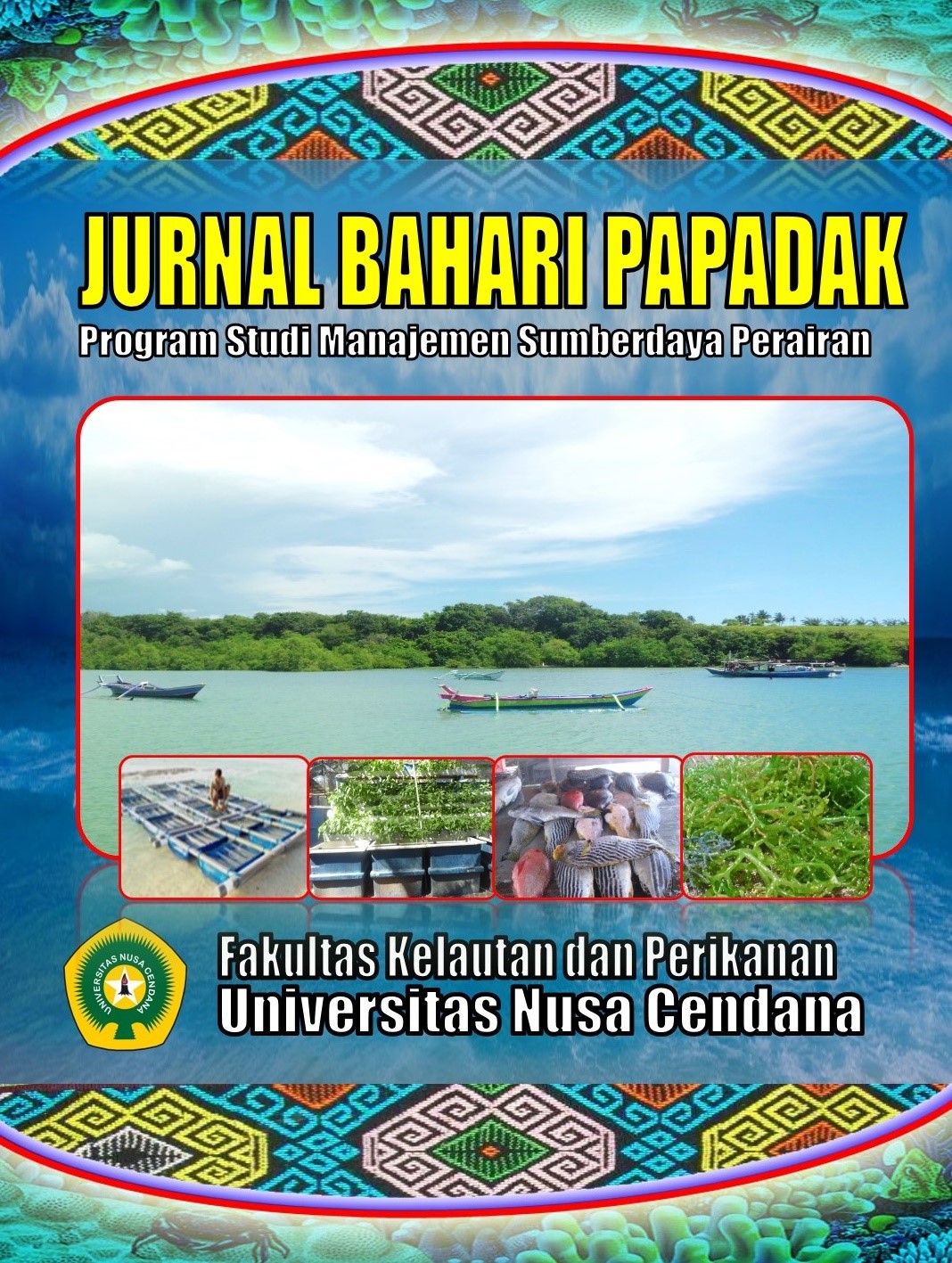PRODUKTIVITAS ALAT TANGKAP LAMPARA DI PPI OEBA, KOTA KUPANG
Abstract
Abstrak - Penelitian ini dilaksanakan selama 1 bulan yaitu yang bertempat Di PPI Oeba, Kota Kupang, Provinsi Nusa Tenggara Timur. Tujuan penelitian yang ingin dicapai adalah menghitung nilai produktivitas alat tangkap Lampara di PPI Oeba, Kota Kupang. Metode yang digunakan adalah metode studi kasus (case study) menggunakan survei yaitu mengambil sampel dari suatu populasi dan menggunakan kuesioner yang telah disusun sebelumnya sebagai alat pengumpul data primer. Produksi hasil tangkapan Lampara dari 15 unit kapal dapat diketahui jenis ikan yang tertangkap adalah ikan pelagis kecil yang hidup di permukaan perairan. Jenis-jenis ikan yang tertangkap adalah Kembung (Rustrelliger kanagurta) dengan total sebesar 23.667 kg (34,3 %), Tembang (Sardinella fimbriata) dengan total sebesar 16.000 kg (23,2 %), Tongkol (Euthynnun sp) dengan total sebesar 16.667 kg (24,2 %), Layang (Decapterus russelli) dengan total sebesar 3.333 kg (4,8 %), Selar (Selaroides spp) sebesar 5.000 kg (7,2 %), dan Cumi-cumi (Loligo sp) sebesar 4.333 kg (6,3 %). Dari jumlah data rata-rata, ikan yang banyak tertangkap dan nilai produksi terbesar adalah ikan kembung sebanyak 23.667 kg (34,2 %) serta nilai terendah adalah ikan layang sebanyak 3.333 kg (4,8 %). Total produksi berdasarkan total hasil tangkapan dari keseluruhan spesies maka total produksi hasil tangkapan Lampara dari 15 armada kapal yang di daratkan di Pangkalan Pendaratan Ikan Oeba sebesar 69.000 kg. Produktivitas alat tangkap Lampara mengalami peningkatan dan penurunan. Pada alat tangkap Lampara, produktivitas tertinggi terdapat pada kapal no. 2 yaitu sebesar 50 kg/org/trip. Sedangkan produktivitas terendah terpadat pada kapal no. 3 yaitu sebesar 10,4 kg/org/trip. Produktivitas rata-rata alat tangkap Lampara dari 15 kapal nelayan Lampara yang berada Di Pangkalan Pendaratan Ikan Oeba yakni sebesar 18,4 kg/org/trip.
Kata Kunci : Lampara, Hasil Produksi, Tingkat Produktivitas
Abstract - This research was carried out for 1 month, which took place at PPI Oeba, Kupang City, East Nusa Tenggara Province. The research objective to be achieved is to calculate the productivity value of Lampara fishing gear at PPI Oeba, Kupang City. The method used is a case study method using a survey, namely taking a sample from a population and using a questionnaire that has been prepared previously as a primary data collection tool. The production of Lampara's catch from 15 ships can be seen that the type of fish caught is small pelagic fish that live on the surface of the waters. The types of fish caught were bloated (Rustrelliger kanagurta) with a total of 23,667 kg (34.3 %), Tembang (Sardinella fimbriata) with a total of 16,000 kg (23.2 %), tuna (Euthynnun sp) with a total of 16,667 kg (24.2 %), Layang (Decapterus russelli) with a total of 3,333 kg (4.8 %), Selar (Selaroides spp) of 5,000 kg (7.2 %), and Squid (Loligo sp) of 4,333 kg (6.3 %). From the average number of data, the most caught fish and the largest production value was mackerel as much as 23,667 kg (34.2%) and the lowest value was scad fish as much as 3,333 kg (4.8%). Total production is based on the total catch of all species, so the total production of Lampara's catch from 15 ships ashore at the Oeba Fish Landing Base is 69,000 kg. The productivity of Lampara's fishing gear has increased and decreased. In Lampara fishing gear, the highest productivity is found in ship no. 2, which is 50 kg/person/trip. While the lowest productivity is densest on ship no. 3, which is 10.4 kg/person/trip. The average productivity of Lampara fishing gear from 15 Lampara fishing boats at the Oeba Fish Landing Base is 18.4 kg/person/trip
Keywords : Lampara, Results of Production , Level ff Productivity

 Fransiskus Mao(1*)
Fransiskus Mao(1*)


